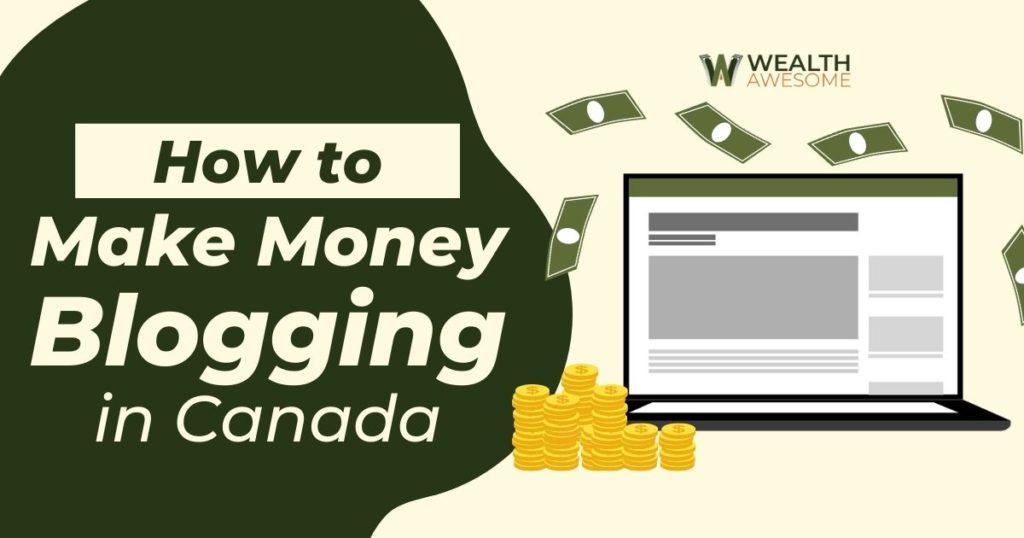Want to learn how to make money blogging? With so many people working from home, blogging has surged in popularity around the world.
Blogging can be an interesting, fun, and fulfilling way to make money. I earn money from blogging and it allows me to travel the world full-time.
When I started writing in 2019, I had no idea about all the different ways on how to make money blogging in Canada.
I now consider myself a seasoned veteran of blogging, so I thought I’d share all the different ways that I’ve discovered you can monetize your blog. Then, I’ll take you through the steps you’ll need to do in order to start the blog and begin writing!
1. Advertising
Earning per thousand pageviews: $5 – $40+
Potential earnings per month: $50 – $10,000+
Running ads on a blog is one of the most effective ways to monetize your writing. It can provide a steady income stream for your platform, whereas many other ways to monetize can be much more sporadic.
Your earnings are usually listed as Revenue Per Mille (RPM) or Cost Per Mille (CPM). This simply means how much your revenue is per thousand pageviews or sessions.
The CPM and RPMs can range drastically for each website. If you get a premium ad manager, you can expect somewhere between $10 – $40 per thousand pageviews. So if you have 100,000 pageviews, you can expect to earn between $1,000 – $4,000.
Niche Selection Matters For Your Payouts
Certain niches pay much higher than others. Basically, the more disposable income the audience of a niche has, the more money it will pay. For example, if you are in an entertainment niche that has mostly teenage readers, it will probably pay much less than a niche such as technology or business, which will generally have older readers that can spend more money.
- High-paying niche examples: Automotive, family, home, and garden, finance, travel
- Low-paying niche examples: News, literature, geography, comedy
How to Get Started with Ads
Many people start advertising using AdSense, which is Google’s popular ad network. The signup process is quite easy, and you won’t need that many visitors or content in order for you to get started. Once you have 20 or 30 blog posts, you can apply for AdSense.
I will recommend that you get off of AdSense as quickly as possible and sign onto a premium ad manager. AdSense is known to have very low payouts, and the ads aren’t optimized for revenue.
Many people report earning more than double of what they were earning at AdSense after they partner with a premium ad manager. Here’s what I would recommend for a newer blogger:
- Apply to AdSense after you have 20 blog posts
- Switch to Ezoic after you have 10,000 pageviews per month
- Once you hit 30,000 visitors per month, you can apply for a premium ad network such as Newor Media.
If you already have a bit of traffic coming to your site, you can use this online earnings calculator to estimate how much you could potentially be earning per month.
Pros of Advertising On your Blog
- Easy to get started and setup
- Consistent monthly income
- It can be quite lucrative
Cons of Advertising
- Slows down your website significantly unless you’re with a premium ad manager which optimizes for speed.
- The website will not look esthetically pleasing
2. Affiliate Marketing

Earning per product referral: $3 – $100+
Potential earnings per month: $20 – $5,000+
Have you ever liked a product or service so much that you had to tell all of your friends? Well, that’s essentially what affiliate marketing is, but on a larger scale. Plus, you get paid for it.
The Products You Choose Matter
You can become an affiliate partner for almost any type of product out there, but that does not mean they are created equal. You should only partner and recommend products that you believe in personally. Also, generally speaking, the higher the price of the product or service, the bigger your commission will be.
Don’t just be limited by physical products, either. Digital products can pay a huge percentage of their revenue to you since you’re opening up your audience to them. Some course providers for instance can pay you 50% of the revenue if you get someone to sign up for their course.
How to Get Started
Many people start off by becoming an Amazon affiliate. Since there are so many products and listings, it’s an easy beginner platform to try out affiliate marketing.
Don’t be stuck on that, though. There are dozens of affiliate networks out there, such as Clickbank, Rakuten, and many more. Your specific niche might even have its own affiliate networks that can help provide you with more specialized offers that are more suitable for its niche.
Research your competitors or top performers in your niche, and see what they are recommending as an affiliate offer.
Pros of Affiliate Marketing
- Can become a lucrative stream of income
- The strong satisfaction of making money by recommending products that you strongly believe in
- Don’t waste time by creating your own products
- Don’t have to do customer support
Cons of Affiliate Marketing
- If you overdo your affiliate marketing, readers can be turned off
- If you recommend a product that your readers don’t like, you can lose credibility.
3.Creating Digital Products

Earning per product: $10 – $1000+
Potential earnings per month: $100 – $20,000+
A digital product is something you buy online that is not a physical product or a service. Some examples can be an online course, a mobile app, workbooks, e-books, and spreadsheets, to name a few. If you have a large enough audience, it can potentially be your largest income generator because you are keeping the money all to yourself.
Digital Products – High Risk, High Reward
Unlike the first two monetization methods on this list, creating a digital product entails more of an investment. You’ll either be investing money, time, or both, depending on the product.
Creating a simple spreadsheet or short e-book for your audience to buy won’t be that much of an investment. But if you’re creating an in-depth course or a mobile app, it could take months and thousands of dollars to develop.
You could invest all that only to have your product flop. On the flip side, if it’s a huge success, you can make tens or even hundreds of thousands of dollars from your product.
How to Get Started Creating a Digital Product
Here are a few steps to follow:
- Do market research to determine if there’s a demand for your product. This might be the most important step and could save you months of your time.
- Plan out how you will develop the product. Will you do most of it yourself, or will you outsource it to others?
- Develop the product
- Market and launch the product
- Sit back, and see the money roll in! (Or not, if it fails, of course)
Pros of Creating a Digital Product
- It can be an extremely lucrative way to monetize your blog
- You have full creative control over your product
- It can be very satisfying to create something from scratch that benefits people.
Cons
- Can take a lot of time and money
- The product can fail
4. Generating Leads

Earning per lead: $30 – $1000+
Potential earnings per month: $30 – $5,000+
Blogs that generate leads for companies or individuals are usually directed towards services. Think leads for services such as plumbers, realtors, roofers, accountants, life insurance, and lawyers.
Depending on what you’re referring lead to, you might need to learn how to properly do local search engine optimization (SEO) by targeting a specific person or company in your city.
You can earn a lot of money by generating leads. Life insurance leads for example, can be surprisingly lucrative, paying hundreds or even thousands of dollars per closed sale.
How to Get Started
Take a look at what you’ve already written on your blog. If you already have articles that are getting traffic, that could potentially be suitable to generate leads. For example, if you have a blog post reviewing the top realtors in your city, this can be a natural way to generate leads for a specific realtor.
If you don’t already have that type of content on your blog, consider creating a few article ideas and plan on how you could target lead generation.
Pros of Lead Generation
- Can feel great to help out someone on a personal level, and get paid for it
- Can lead to interesting personal connections and friendships formed
Cons of Lead Generation
- Difficult to scale for a large audience, and usually is constricted to a more local service.
5. Sponsored Posts

Earning per post: $100 – $10,000+
Potential earnings per month: $100 – $20,000+
Depending on how big your audience is and how deep the pockets of your partner company is, sponsored posts can provide a huge sum of money for bloggers. Because bloggers connect with their audience on a more intimate level, companies are keen to partner with them to market their products in a different way.
A Brand Ambassador
If a company is willing to sponsor you to write a post, they are saying that they believe you embody their brand and they want to partner with you. But also remember that it goes both ways. If you believe in the brand and product and want to partner with them, then go for it.
But don’t just jump and say yes to the highest bidder if you don’t believe in the product yourself. It could hurt your reputation and blog if you partner with something that doesn’t suit you or your audience.
How to Get Started With Sponsored Posts
If your blog grows big enough, you’ll start getting sponsored post offers without much effort. It’s then your job to vet them properly and see which ones you want to accept.
You can also be more proactive and approach companies yourself. Create a list of 10 brands you would love to work with. When the timing is right, and you feel you can provide enough value, start approaching them with your offerings.
Pros of Sponsored Posts
- Can be a relatively easy way to earn a large lump sum of money
- If it’s a good partner, it can be recurring revenue if they want to do one every few months.
Cons of Sponsored Posts
- If you write a sponsored post for someone who isn’t suitable for your brand, it’s not a good look for your blog.
- If done improperly, sponsored posts can look biased to your audience.
6.Showcase Your Freelancing Skills

Earning per client hire: $100 – $1000
Potential earnings per month: $100 – $5,000+
By becoming a good writer and attracting a following, you might not know it, but you’re displaying your skills to a potential employer.
I’ve gotten many offers to hire me as a writer since I started my blog without even trying to attract any clients. An example of one of my clients is CTV News, where I am a personal finance columnist.
They will usually try to hire you as a writer, but if you have niche-specific skills it can be for something else. For example, if you have a popular gardening blog, you might get an offer to appear on a podcast or to do a Youtube collaboration for a product.
How to Get Started
If you’re like me and this wasn’t really a focus for you, concentrate on growing your blog, and the freelance offers will start coming your way.
If you want to target this source of income more aggressively, have a services page on your website that outlines what you offer and your potential rates and contact information. You can also include your services in your about me section or even your homepage and blog posts.
Pros of Freelancing
- You can learn a lot by working with others.
- Another reliable stream of income that is separate from your business
Cons
- You will have an employer again, so if you started this to get out of the 9-5 life, this might not be that appealing.
How to Start a Blog in Canada – FIve Steps

Alright, so now that you know how to make money from blogging, how do you actually get started with it?
It’s a lot easier to start a blog these days, but there are still a few steps and a learning curve to it.
1. Plan Out Your Site
You’ll have to figure out what you want to write about. It’s best to focus on a certain niche, for example, travelling in vans has become a popular niche (van life!).
But don’t get too niche-specific, as it might not reach a wide enough audience. For example, if you’re doing a food blog, don’t limit yourself to one city. You’ll have to find a happy medium.
Brainstorm and plan out the first 10-20 article ideas, your domain name, and how you want it to look and feel.
2. Buy Domain
After you figure out how you want to brand your website, purchase the domain name. I always recommend choosing a dot com (www.examplesite.com) over something like a .ca or .co.uk, as it has universal appeal.
Namecheap usually has the cheapest domains, but there are some problems with signup sometimes. Siteground is another good option to buy a domain, and if you bundle it with hosting, it’s a bit cheaper.
3. Hosting
Buying a domain only means you own that URL. You will have to host it somewhere with a server and buy a hosting package. For beginners, I recommend Siteground, as it has an excellent starter package that’s very cheap for the first year. After your site grows, WPX is a solid option with fantastic support staff.
4. Design Website
If you have some tech knowledge or time to learn it, start building your website. Most bloggers use WordPress, and for good reason, as that’s what the platform was originally intended for. You can also hire someone off a platform like Upwork or Fiverr for reasonably cheap to help you build it, usually for around a few hundred dollars.
5. Start Writing
Now you can finally start writing! Take the 10-20 articles you had planned, then start your blogging journey by sitting down and writing. Try to set a daily writing goal of at least 500 words and stick to a schedule.
Conclusion
Hopefully, after you are established, you can start to earn money from the various ways listed above.
When I started my writing career, I had no idea about all the different ways on how to make money blogging in Canada. Blogging can be a great way to earn passive income, so get started today!







Hi, Good day. This is a perfect guide for any beginner in the world of blogging and want to make money online throgh the blogging. It can often be super confusing when you are new to blogging and you may not be aware of how to go about things. This article is great as it talks about the various factors that can make blogging good. I agree with every single point that has been mentioned above.